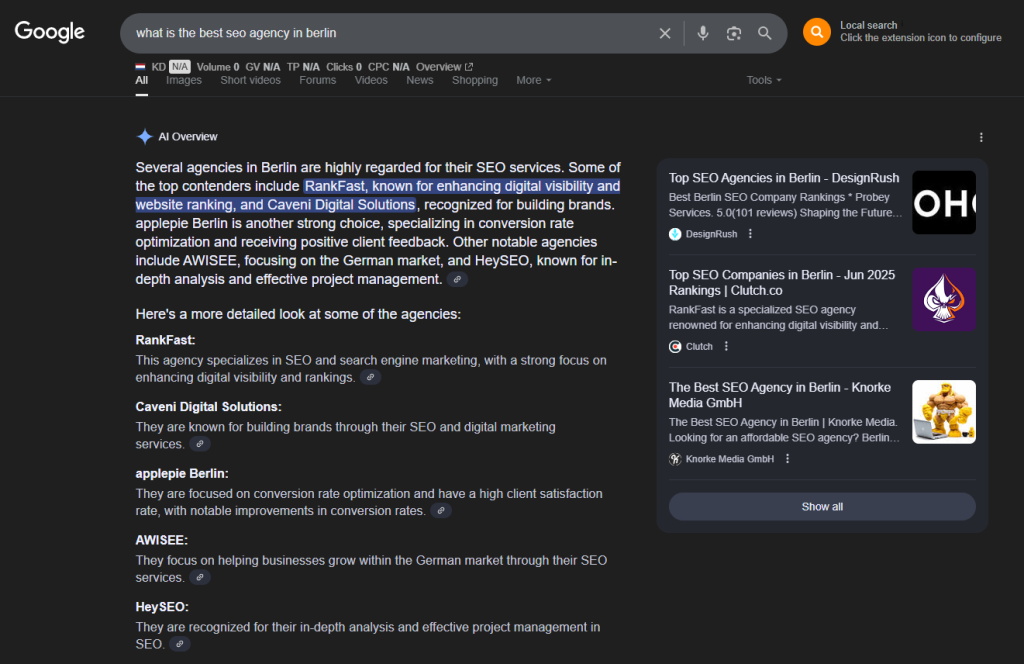The battle for online visibility has entered a new era. While SEO (Search Engine Optimization) continues to drive traditional search rankings, GEO (Generative Engine Optimization) has emerged as the essential strategy for appearing in AI-powered search experiences like ChatGPT, Google’s AI Mode, and other conversational platforms.
Understanding the difference between GEO vs SEO isn’t just academic—it’s becoming critical for digital marketers who want to maintain visibility as search technology rapidly evolves.
The fundamental shift?
Instead of optimizing for algorithms that rank pages, you’re now optimizing for AI systems that synthesize information from multiple sources to generate comprehensive answers.
You are currently viewing a placeholder content from YouTube. To access the actual content, click the button below. Please note that doing so will share data with third-party providers.
More InformationUnderstanding the fundamentals: what are GEO and SEO?
Let’s start with what you already know. Search Engine Optimization (SEO) is the practice of improving your website’s visibility in traditional search engine results pages.
When someone types a query into Google, SEO helps your content appear in those familiar blue links we’ve all clicked thousands of times. It’s about keywords, backlinks, page speed, and hundreds of other ranking factors that search algorithms use to determine which pages best answer a user’s query.
But here’s where things get interesting. Generative Engine Optimization (GEO) represents a completely different approach to online visibility. Instead of competing for rankings on a results page, GEO focuses on getting your content cited and referenced within AI-generated responses.
Understanding the benefits of Generative Engine Optimization can help you leverage this new approach effectively.
When someone asks ChatGPT a question or triggers Google’s AI Mode, these systems don’t just retrieve links—they synthesize information from multiple sources to create a comprehensive answer.
What is Google AI Mode you ask?
Google’s new AI Mode (opt-in via Search Labs) turns Search into a conversational assistant that breaks your question into sub-topics, pulls answers from high-quality web sources, and lets you ask follow-ups—falling back to plain links if confidence is low. It’s experimental (U.S., English, age 13 +; Workspace Edu 18 +), works best with Web & App Activity on, and is expeted to replace the traditional Google Search in the near future.
Video on how Google AI Mode will work in the future
You are currently viewing a placeholder content from YouTube. To access the actual content, click the button below. Please note that doing so will share data with third-party providers.
More InformationThink of it this way: SEO is like getting your book placed prominently on a library shelf where people can find it. GEO is like having the librarian quote your book when answering someone’s question directly. Both get your information to the user, but through fundamentally different mechanisms.
The primary objective of SEO remains driving traffic to your website through improved rankings.
You optimize your content, build authority through links, and enhance technical performance to climb those search results. GEO, on the other hand, aims for something entirely different: citation visibility.
Success isn’t measured by clicks anymore—it’s measured by how often AI systems reference your content as a credible source when constructing their responses.
Understanding Search Query Types: Normal vs AI Overview Triggers
Not all search queries are created equal when it comes to triggering AI responses. Understanding which types of queries generate traditional search results versus AI overviews is crucial for developing effective optimization strategies. The table below shows examples of search queries that typically trigger normal search results compared to those that activate Google’s AI overviews.
| Normal Search Queries | AI Overview Triggering Queries |
|---|---|
| Nike official website | How do running shoes affect knee pain? |
| Amazon login | What are the best laptops for video editing in 2025? |
| Facebook.com | How to start a small business from home? |
| YouTube | What causes climate change and how can we prevent it? |
| Local pizza delivery near me | How to lose weight safely and effectively? |
| Weather forecast today | What are the benefits of meditation for mental health? |
| Stock price AAPL | How to choose the right college major for your career? |
| Movie showtimes | What is the difference between AI and machine learning? |
| Bank of America login | How to improve your credit score quickly? |
| ESPN scores | What are the most effective study techniques for students? |
What are the most important studies on GEO and its impact on SEO in 2025?
From peer-reviewed breakthroughs to data-rich field audits, the latest studies show that generative search rewards explicitly cited, entity-dense content while exposing new attack surfaces like prompt-injection—upending yesterday’s SEO playbook overnight. Hard numbers from iPullRank, Ahrefs and Semrush confirm the stakes:
Google’s AI Overviews can slash top-slot CTR by a third even as AI-referral traffic surges ten-fold, turning Generative Engine Optimization (GEO) into an existential KPI for any publisher who wants to stay findable, clickable, and trusted in 2025 and beyond.
Flagship Studies Shaping GEO
Generative Engine Optimization isn’t just the next bullet-point on your 2025 marketing roadmap—it’s a fast-moving research frontier that’s rewriting the rules of search visibility. The papers below are the anchor texts of that new reality: they coin the terminology, expose the blind spots of current LLM-powered engines, and even reveal how adversaries can poison the well. Give them a skim and you’ll understand not only why traffic is shifting, but also how to steer the shift in your favor.
| # | Study (chronol.) | Core contribution | Why it matters |
|---|---|---|---|
| 1 | Aggarwal et al., “GEO: Generative Engine Optimization” (KDD 2024) | Coins the term GEO, formalises “visibility” (citation share, position, sentiment) and releases GEO-Bench; black-box rewriting boosts citation share by ~40 %. | Establishes the first reproducible benchmark—think “PageRank moment” for generative search. Marketers can A/B-test content against GEO-Bench to quantify AI-traffic loss. |
| 2 | Liu, Zhang & Liang, “Evaluating Verifiability in Generative Search Engines” (EMNLP Findings 2023) | First large-scale audit of Bing Chat, Perplexity, YouChat & NeevaAI: only 51.5 % of sentences are fully supported by their citations; citation precision averages 74.5 %. | Low recall means even well-optimised pages can be omitted. Underscores value of “explicit support” tactics (numbered fact-blocks, primary-source links). |
| 3 | Sharma & Dhiman, “Impact of AI-Powered Search on SEO: The Emergence of AEO” (Apr 2025) | Mixed-methods study across Google SGE, Perplexity & ChatGPT; projects 25 % drop in traditional search traffic by 2026. Provides a taxonomy of GEO / AEO tactics. | Translational research: turns GEO theory into a marketer’s playbook and highlights the need to track brand-mention share alongside classic rankings. |
| 4 | Zhang et al., “Imperceptible Content Poisoning in LLM-Powered Applications” (ASE 2024) | Shows benign-looking trigger patterns can hijack retrieval-plus-generation stacks with 72 % success. | The “dark-side” of GEO: if you can raise visibility, you can also subvert it. Calls for source-reputation scoring & adversarial-training defences. |
| 5 | Shi et al., “JudgeDeceiver: Prompt-Injection Attack to LLM-as-a-Judge” (ACM CCS 2024) | Gradient-free suffixes systematically sway LLM “judge” modules—including those that re-rank citations. | Ranks themselves are attack surfaces; content must be visibility-robust (e.g. signed sources, resistant to anchor spoofing). |
Cross-cutting implications
- Publishers & brands: Explicit evidence beats implicit relevance—think structured citations, entity-first headlines and numbered fact blocks.
- Search & answer-engine vendors: Optimisation and adversarial research are two sides of the same coin; expect short-term patches (trust tiers) and medium-term provenance tracking.
- Regulators: Citation recall/precision are emerging audit metrics that could slot into DMA-style transparency rules.
- Open research questions: Domain-specific optimisation (health, finance), factuality × visibility trade-offs, and defences that avoid penalising small publishers.
Practice checklist for 2025
| Action | Backed by | Quick test |
|---|---|---|
| Add numbered fact-blocks with primary-source citations | Aggarwal et al. | Check if Perplexity cites you within 72 h. |
| Use entity-rich titles (“Topic: what Audience needs in 2025″) | Sharma & Dhiman | Ask GPT-4o for a zero-shot summary—does it name your brand? |
| Monitor citation-recall weekly | Liu et al. | If <60 %, expand FAQ / How-To schema. |
Implement content-signatures or rel=me canonicals |
Zhang et al. | Mitigates trigger-style poisoning. |
| Fuzz-test pages with suffix attacks pre-launch | Shi et al. | Look for tone/logical shifts in GPT answers. |
Publisher-led Research Driving Generative Engine Optimization
If the academic work is the theory, the studies from iPullRank, Ahrefs, and Semrush are the field reports. These data-rich audits translate lofty concepts into bottom-line impact: how many clicks vanish in Google’s AI Overviews, which verticals are bleeding the fastest, and where AI-referral traffic is already outpunching classic SEO. Think of this section as your reality check— numbers you can paste straight into a forecast deck or hand to the C-suite when they ask, “So what’s GEO really worth?”
| # | Publisher / Study (year) | Core insight | Why it matters |
|---|---|---|---|
| 1 | iPullRank — “Referral Patterns in Google AI Mode” (2025) | First traffic audit based on 100 K AI-Mode users (SimilarWeb panel). Only 4.5 % of AI-Mode sessions generate an external click vs 24 % in classic Search. | Confirms that conversational search is overwhelmingly “zero-click.” Marketers must optimise for brand mentions and rich snippets, not just CTR. |
| 2 | iPullRank — “The Ultimate AI Overviews (SGE) Guide” (2024) | Mega-guide synthesising 50 + third-party studies; introduces the “SGE Threat Report” template for vertical impact forecasting. | Became a field manual for early GEO: load-time benchmarks, source-ranking patterns, and pixel-depth analysis still referenced in 2025 playbooks. |
| 3 | Ahrefs — “AI Traffic Has Increased 9.7×” (2025) | Dataset of 81 947 websites shows 21 % drop in traditional search traffic and 10× growth in AI-referral traffic YoY; ChatGPT now sends more visits than Reddit. | Quantifies the “traffic swap” phenomenon and tips marketers to track AI referrers separately from organic search in analytics. |
| 4 | Ahrefs — “AI Overviews Reduce Clicks by 34.5 %” (2025) | Analysis of 300 000 keywords finds AI Overviews cut position-1 CTR from 4.0 % to 2.6 %, a 34.5 % relative decline. | Hard evidence that occupying the top organic slot is no longer a CTR guarantee; fuels investment in GEO tactics like “chunkable” fact blocks. |
| 5 | Semrush — “Impact of AI Search on SEO Traffic” (2025) | 500 high-value topics; projects AI-search visitors will surpass traditional search by 2028 and are worth 4.4× more per visit. | Puts a revenue lens on GEO: not just mitigating loss, but capturing higher-value conversions from AI-qualified users. |
| 6 | Semrush — “AI Overviews Study” (2025) | Deep-dive across 10 M keywords: AI Overviews now trigger on 13.1 % of US queries (up 2 × since January) with largest share gains in Science, Health & Society. | Shows how fast Google is scaling generative answers and identifies verticals where zero-click risk is highest. |
How does GEO differ from traditional SEO practices?
The differences between GEO and SEO run deeper than you might expect. While SEO relies heavily on keyword matching and link authority, GEO operates on an entirely different set of principles.
To understand this evolution, it’s helpful to explore the difference between old SEO and new SEO approaches.
Modern AI systems use what’s called dense retrieval—they convert your content into mathematical representations (vector embeddings) and measure relevance based on semantic similarity rather than exact keyword matches.
Here’s a practical example: In SEO, you might optimize a page about “best running shoes” by including that exact phrase throughout your content, building links with that anchor text, and ensuring your page loads quickly.
For GEO, you’d focus on creating semantically complete passages that answer specific aspects of running shoe selection—cushioning types, pronation considerations, terrain variations—because AI systems evaluate content at the passage level, not the page level.
| Optimization Factor | SEO Approach | GEO Approach |
|---|---|---|
| Content Structure | Keyword-focused headings and paragraphs | Question-answering clusters and semantic completeness |
| Authority Signals | Backlinks and domain authority | Web mentions and citation frequency |
| User Intent | Matching search queries | Anticipating conversational follow-ups |
| Content Evaluation | Page-level ranking | Passage-level selection |
| Success Metrics | Rankings and organic traffic | Citation rate and answer inclusion |
Perhaps the most striking difference lies in how user intent is interpreted. Traditional search algorithms try to match your query with relevant pages.
But AI systems perform what’s called a “query fan-out”—they generate dozens or even hundreds of related sub-queries to build a comprehensive understanding of what you’re really asking.
Your content might not rank for the original query in traditional search, but it could be perfect for one of those synthetic sub-queries the AI creates behind the scenes.
Why is this paradigm shift happening in search visibility?
Remember when we used to type awkward keyword phrases into Google? “Best pizza restaurant New York cheap.” Now we ask questions like we’re talking to a knowledgeable friend: “Where should I take my family for authentic New York pizza that won’t break the bank?”
This evolution in user behaviour is driving the shift from SEO to GEO.
The technological advancement making this possible is remarkable. Large Language Models now use Retrieval Augmented Generation (RAG), which means they perform real-time searches to gather fresh information before generating responses.
This creates a fast feedback loop—optimize your content today, and it could appear in AI responses tomorrow. Compare that to the old model where AI systems relied on training data that was months or years old.

“The future of search isn’t about ranking on a results page—it’s about becoming the trusted source that AI systems cite when answering user questions.”
Users increasingly expect instant, comprehensive answers rather than a list of links to explore.
When someone asks about the best laptop for video editing, they want a synthesized recommendation that considers their budget, software requirements, and performance needs—not ten different review sites to compare.
AI-powered search delivers exactly this experience, which explains why ChatGPT usage exploded in early 2025 and why Google is rapidly expanding its AI Mode across more search queries.
The convergence of AI chat and traditional search has created a new reality. Platforms like Perplexity, Claude, and Gemini aren’t just chatbots—they’re answer engines that combine conversational AI with real-time web search. This convergence means that optimizing for one channel often benefits the others, making GEO an increasingly essential component of digital marketing strategy.
What are the key optimization strategies for GEO success?
Success in GEO requires a fundamental shift in how you structure and create content.
Instead of targeting individual keywords, you need to think in terms of topic clusters—groups of related questions that your content can comprehensively answer. A single page should address hundreds of related questions with similar intent, not just one primary keyword.
Let’s talk about entity optimization. AI systems excel at understanding relationships between concepts, people, places, and things. When you mention “Tesla,” the AI understands connections to Elon Musk, electric vehicles, sustainable energy, and autonomous driving.
By explicitly defining these entity relationships in your content through structured data and semantic markup, you help AI systems better understand and cite your content.
Content structuring for AI comprehension
Think of your content as a series of self-contained answers rather than one long narrative.
Each paragraph should be semantically complete—able to stand alone as a meaningful response to a specific question. This approach aligns with how AI systems evaluate content at the passage level.
Natural language optimization has become crucial.
Write as if you’re explaining concepts to a colleague over coffee, not stuffing keywords for an algorithm.
Use conversational phrases, rhetorical questions, and clear explanations that mirror how people actually communicate.

Technical considerations for GEO
Structured data implementation goes beyond basic schema markup.
You need to help AI systems understand the relationships between different pieces of information on your site.
Use FAQ schema, Product markup, and other structured formats that explicitly define questions and answers.
Consider this practical framework: Create content that targets question clusters, implement comprehensive structured data, focus on passage-level optimization where each section can standalone, and build topical authority through comprehensive coverage rather than thin, keyword-focused pages.
How can marketers integrate both GEO and SEO effectively?
Here’s the thing—GEO and SEO aren’t competitors.
They’re complementary strategies that, when combined effectively, create a powerful approach to search visibility. Think of it like having both a physical store and an online presence.
You wouldn’t choose just one, would you?
The key is understanding where each strategy excels. SEO remains vital for transactional queries where users want to visit specific websites. Someone searching for “Nike official store” still wants that blue link to Nike.com.
But for informational queries—”how do running shoes affect knee pain”—GEO becomes increasingly important as users prefer comprehensive AI-generated answers.
Start by auditing your content through both lenses.
Which pages drive traditional organic traffic? Keep optimizing those for SEO. Which topics could benefit from comprehensive, question-answering content? Those are your GEO opportunities. The beauty is that well-structured, comprehensive content often performs well in both channels.

Resource allocation strategies
Don’t abandon your SEO efforts—evolve them. Allocate resources based on query intent and business goals. For bottom-funnel, high-intent searches, maintain strong SEO.
For top-funnel, informational content, invest heavily in GEO optimization. Many tactics overlap: creating excellent content, building topical authority, and earning web mentions benefit both strategies.
Measurement frameworks need to track both traditional metrics (rankings, traffic, conversions) and GEO-specific KPIs (citation frequency, answer inclusion rate, share of voice in AI responses).
This dual approach ensures you’re not blindly chasing one strategy while neglecting valuable opportunities in the other.
What tools and metrics should you use to measure success?
Measuring GEO success requires new tools and metrics because traditional rank tracking simply doesn’t work.
When two users ask the same question, they might get completely different AI-generated responses based on their personal context and history. So how do you track performance in this new landscape?
Share of Answer (SOA) has emerged as the primary GEO metric. It measures how often your content appears in AI responses across different platforms and query variations.
Unlike traditional rankings, you need to track multiple surfaces (ChatGPT, Perplexity, Google AI Mode, Claude) and run multiple tests for the same query since responses vary.
To maximize your visibility, learn how to rank in Google AIO, how to rank in ChatGPT, and how to rank in Perplexity for comprehensive AI search optimization.
| Metric Type | Traditional SEO | GEO Focus |
|---|---|---|
| Visibility | Keyword rankings | Citation frequency in AI responses |
| Engagement | Click-through rate | Answer inclusion rate |
| Authority | Domain Rating/Authority | Web mention correlation |
| Performance | Organic traffic | Share of Answer (SOA) |
Tools for GEO measurement range from free options to enterprise solutions.
The key is choosing tools that can track AI responses across multiple platforms, monitor citation patterns, and measure how often your brand or content appears in generated answers. Remember, the most expensive tool isn’t necessarily the best—focus on finding one that reliably tracks the metrics that matter for your business.
Attribution challenges and solutions
One of the biggest challenges in GEO is attribution.
When your content gets cited in an AI response but doesn’t generate a click, how do you measure value? Forward-thinking marketers are developing new attribution models that assign value to citations based on query intent, audience value, and downstream brand impact rather than just direct traffic.
Key takeaways: navigating the future of search visibility
The shift from SEO to GEO isn’t about abandoning everything you know about search optimization. It’s about expanding your toolkit to include strategies that work in an AI-driven search landscape.
The fundamentals remain important—creating excellent content, understanding user intent, and building authority—but the application has evolved dramatically.
Start implementing GEO strategies today by restructuring existing content for AI comprehension.
Take your best-performing SEO content and enhance it with question-answering sections, structured data, and semantically complete passages.
Focus on building web mentions and brand presence across the internet, as these correlate more strongly with AI visibility than traditional backlinks.
What should you do tomorrow?
Audit your content for GEO opportunities, implement structured data for better AI comprehension, create question cluster content that addresses entire topics, and begin tracking Share of Answer metrics alongside traditional SEO KPIs.
The future of search visibility lies in mastering both GEO and SEO. As AI systems become more sophisticated and users increasingly prefer conversational search experiences, the ability to optimize for both traditional and generative engines will separate successful digital marketers from those left behind. The paradigm shift is here—the question isn’t whether to adapt, but how quickly you can evolve your strategy to thrive in this new landscape.
Remember, we’re still in the early days of GEO. Just as SEO evolved from simple keyword stuffing to sophisticated optimization strategies, GEO will continue to develop and mature. By starting now, you’re positioning yourself at the forefront of this evolution, ready to capture visibility wherever your audience seeks information—whether through traditional search results or AI-generated responses.
Frequently Asked Questions
How long does it take to see results from GEO optimization compared to traditional SEO?
GEO results can appear much faster than traditional SEO—sometimes within days rather than months. Since AI systems use real-time retrieval (RAG), your optimized content can start appearing in AI responses almost immediately after indexing. However, building consistent citation authority across multiple AI platforms typically takes 2-3 months of sustained effort, compared to SEO which often requires 6-12 months for significant ranking improvements.
What's the biggest mistake marketers make when transitioning from SEO to GEO?
The most common mistake is treating GEO like keyword-stuffed SEO by cramming questions into content without providing substantive answers. AI systems evaluate semantic completeness and factual accuracy, not keyword density. Instead of listing dozens of questions with thin answers, focus on creating comprehensive, conversational explanations that thoroughly address topic clusters—think of writing for a knowledgeable colleague, not a search algorithm.
Should I create separate content for GEO and SEO, or can the same content serve both purposes?
The same content can absolutely serve both purposes when structured correctly. Start with your existing high-performing SEO content and enhance it with question-answering sections, clear subheadings that address specific queries, and semantically complete paragraphs. The key is ensuring each section can stand alone as a meaningful answer while still maintaining the flow and readability that traditional SEO requires.
How do I track my competitors' GEO performance when AI responses vary by user?
Track competitor GEO performance by running systematic queries across multiple AI platforms using fresh browser sessions or API access to minimize personalization. Focus on monitoring citation patterns for key topics rather than specific queries—look for how often competitors appear across 50-100 related questions in your niche. Tools that aggregate AI responses can help, but manual spot-checking remains valuable for understanding citation context and quality.
What technical skills or tools do I need to implement GEO that I might not already have from SEO?
While many SEO skills transfer to GEO, you'll need to expand your structured data expertise beyond basic schema to include FAQ, How-to, and Qu0026A markup. Understanding vector embeddings and semantic search concepts helps, though you don't need to be a data scientist. The main new tools you'll need are AI response trackers and citation monitors—start with free options like manual tracking in spreadsheets before investing in specialized GEO platforms.
How do I justify GEO investment to stakeholders when it doesn't directly drive website traffic?
Frame GEO value in terms of brand visibility and thought leadership rather than direct traffic. Show stakeholders that being cited as an authoritative source in AI responses builds trust and influences purchase decisions, even without clicks. Track branded search increases after GEO implementation, monitor sales or lead quality improvements, and demonstrate how GEO citations often precede direct website visits through other channels—creating a halo effect that traditional attribution misses.






